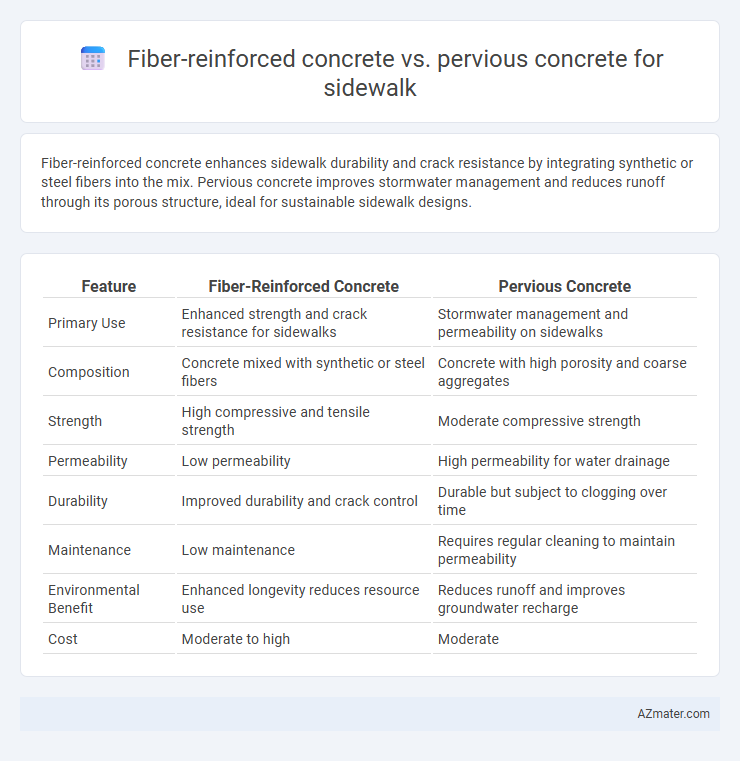Fiber-reinforced concrete enhances sidewalk durability and crack resistance by integrating synthetic or steel fibers into the mix. Pervious concrete improves stormwater management and reduces runoff through its porous structure, ideal for sustainable sidewalk designs.
Table of Comparison
| Feature | Fiber-Reinforced Concrete | Pervious Concrete |
|---|---|---|
| Primary Use | Enhanced strength and crack resistance for sidewalks | Stormwater management and permeability on sidewalks |
| Composition | Concrete mixed with synthetic or steel fibers | Concrete with high porosity and coarse aggregates |
| Strength | High compressive and tensile strength | Moderate compressive strength |
| Permeability | Low permeability | High permeability for water drainage |
| Durability | Improved durability and crack control | Durable but subject to clogging over time |
| Maintenance | Low maintenance | Requires regular cleaning to maintain permeability |
| Environmental Benefit | Enhanced longevity reduces resource use | Reduces runoff and improves groundwater recharge |
| Cost | Moderate to high | Moderate |
Introduction to Sidewalk Material Innovations
Fiber-reinforced concrete enhances sidewalk durability by incorporating synthetic or steel fibers that reduce cracking and improve tensile strength, making it ideal for high-traffic areas. Pervious concrete offers superior stormwater management by allowing water to permeate through its porous structure, reducing runoff and promoting groundwater recharge. Innovations in sidewalk materials increasingly prioritize environmental sustainability and longevity, with fiber-reinforced and pervious concrete addressing structural integrity and eco-friendly drainage needs.
Overview of Fiber-Reinforced Concrete
Fiber-reinforced concrete integrates synthetic or steel fibers to enhance tensile strength, durability, and crack resistance, making it highly suitable for sidewalks subjected to varying loads and environmental stress. Its improved impact resistance and reduced shrinkage cracking promote longer service life compared to traditional concrete types. Unlike pervious concrete, fiber-reinforced concrete offers a dense matrix, prioritizing structural integrity over permeability.
Overview of Pervious Concrete
Pervious concrete is a highly porous material designed to allow water to pass through, reducing surface runoff and promoting natural groundwater recharge, making it ideal for sustainable sidewalk construction. Its composition includes coarse aggregates with minimal fine materials, resulting in permeability rates typically between 2 to 12 gallons per minute per square foot. While it offers excellent stormwater management benefits, pervious concrete requires proper maintenance to prevent clogging and ensure long-term durability in pedestrian applications.
Structural Performance Comparison
Fiber-reinforced concrete exhibits superior tensile strength and crack resistance compared to pervious concrete, enhancing durability and load-bearing capacity for sidewalks. Pervious concrete prioritizes permeability to manage stormwater but typically demonstrates lower compressive strength and reduced resistance to freeze-thaw cycles. The structural performance of fiber-reinforced concrete ensures longer lifespan and improved safety under pedestrian and light vehicular loads, whereas pervious concrete offers environmental benefits with trade-offs in mechanical robustness.
Durability and Longevity Factors
Fiber-reinforced concrete enhances durability by improving tensile strength and crack resistance, making it ideal for sidewalks exposed to heavy foot traffic and varying weather conditions. Pervious concrete supports longevity by allowing water infiltration, reducing surface water accumulation and freeze-thaw damage, but generally has lower compressive strength compared to fiber-reinforced options. Sidewalk projects prioritizing crack control and load-bearing capacity benefit from fiber reinforcement, while those needing efficient stormwater management may prefer pervious concrete despite potential durability trade-offs.
Permeability and Drainage Capabilities
Fiber-reinforced concrete offers enhanced tensile strength and crack resistance but has relatively low permeability, making it less effective for drainage in sidewalk applications. Pervious concrete is specifically designed with high porosity to allow water to pass through, significantly improving stormwater management and reducing runoff. Selecting pervious concrete for sidewalks maximizes permeability and drainage capabilities, promoting sustainable urban water practices.
Maintenance and Repair Considerations
Fiber-reinforced concrete offers enhanced durability and crack resistance, reducing maintenance frequency and lowering repair costs for sidewalks compared to pervious concrete. Pervious concrete requires regular cleaning to prevent clogging and maintain permeability, which can increase ongoing maintenance efforts. Repairing fiber-reinforced concrete typically involves patching small cracks, while pervious concrete repairs often demand complete slab replacement to restore proper drainage.
Cost and Installation Efficiency
Fiber-reinforced concrete offers enhanced durability and crack resistance at a moderate increase in material cost but provides faster installation due to reduced need for control joints and labor-intensive reinforcement placement. Pervious concrete, designed for drainage and stormwater management, typically involves higher installation costs and longer application times given its specialized mix and curing requirements, but it significantly reduces long-term maintenance expenses by mitigating water pooling and surface runoff. When prioritizing cost efficiency and installation speed for sidewalks, fiber-reinforced concrete generally delivers better immediate value, while pervious concrete provides ecological benefits that may justify its upfront investment in sustainable urban drainage systems.
Environmental Impact and Sustainability
Fiber-reinforced concrete enhances durability and reduces crack propagation, resulting in longer-lasting sidewalks with decreased resource consumption for repairs and maintenance. Pervious concrete promotes sustainable stormwater management by allowing water infiltration, reducing runoff, and recharging groundwater, thus mitigating urban flooding and pollution. Both options contribute to environmental sustainability, with fiber-reinforced concrete focusing on structural longevity and pervious concrete emphasizing ecological benefits through water permeability.
Which Concrete Type is Best for Sidewalks?
Fiber-reinforced concrete offers superior tensile strength and crack resistance, making it ideal for sidewalks subjected to heavy foot traffic and varying weather conditions. Pervious concrete excels in stormwater management by allowing water to pass through, reducing runoff and improving drainage for environmentally sensitive areas. Sidewalks in urban or high-traffic zones benefit most from fiber-reinforced concrete, while pervious concrete is best suited for locations prioritizing sustainability and flood mitigation.

Infographic: Fiber-reinforced concrete vs Pervious concrete for Sidewalk
 azmater.com
azmater.com